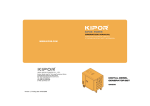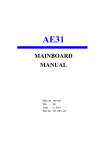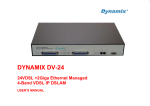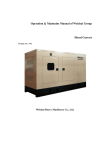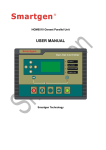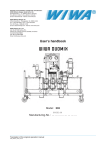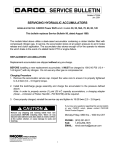Download Battery
Transcript
Battery Battery Battery Battery Type of battery Type of battery • • Check that the battery used in this truck is the correct voltage as shown on the truck’s data plate. Use a traction battery having a weight within the minimum/maximum values stated on the data plate. Check that the battery used in this truck is the correct voltage as shown on the truck’s data plate. Use a traction battery having a weight within the minimum/maximum values stated on the data plate. Changing the battery Changing the battery • • Only replace the battery with a battery of the same weight as the original. The battery weight affects the truck’s stability and its braking capacity. Information on the lowest permitted battery weight can be found on the truck’s data plate. WARNING Risk of moving the center of gravity. A battery weight that is too low gives impaired stability and braking capacity. The battery weight must be in accordance with the information on the truck’s data plate. Only replace the battery with a battery of the same weight as the original. The battery weight affects the truck’s stability and its braking capacity. Information on the lowest permitted battery weight can be found on the truck’s data plate. WARNING Risk of moving the center of gravity. A battery weight that is too low gives impaired stability and braking capacity. The battery weight must be in accordance with the information on the truck’s data plate. When changing the battery proceed as follows: When changing the battery proceed as follows: • Park truck at battery removal station. • Park truck at battery removal station. • Turn OFF key and remove. • Turn OFF key and remove. • Push the emergency disconnect button to the OFF position to stop hourmeter from running. • Push the emergency disconnect button to the OFF position to stop hourmeter from running. • Disconnect the battery connector from the battery. • Disconnect the battery connector from the battery. • Remove battery stops. • Remove battery stops. Return 55 55 Battery Battery • Slide out the discharged/old battery, then slide in the new battery. • Slide out the discharged/old battery, then slide in the new battery. • Connect battery and truck connectors. • Connect battery and truck connectors. • Connect the battery connector and truck connector. • Connect the battery connector and truck connector. WARNING Risk of short-circuiting. The cables can be damaged and cause a short-circuit. Ensure the battery cables are not crushed. WARNING Risk of short-circuiting. The cables can be damaged and cause a short-circuit. Ensure the battery cables are not crushed. • Push the emergency disconnect button to the ON position. • Push the emergency disconnect button to the ON position. • Install battery stops. • Install battery stops. WARNING Falling battery. If the truck should tip over the battery can fall out if the battery stops have not been installed. Make sure the battery stops have been installed. WARNING Falling battery. If the truck should tip over the battery can fall out if the battery stops have not been installed. Make sure the battery stops have been installed. WARNING Falling battery. When charging the battery, it can be dropped. Always lift battery using an approved lifting device, and use a battery yoke intended for the battery. WARNING Falling battery. When charging the battery, it can be dropped. Always lift battery using an approved lifting device, and use a battery yoke intended for the battery. Return 56 56 Battery Battery Charging the battery Charging the battery General prohibition General prohibition When recharging the battery it is absolutely forbidden to smoke or use an open flame. When recharging the battery it is absolutely forbidden to smoke or use an open flame. Use an automatic charger intended for recharging traction batteries. Use an automatic charger intended for recharging traction batteries. The charger must have an automatic maintenance charging feature for a certain period after the main charging period has been completed. This eliminates the risk of over charging the battery and the need to monitor the charging procedure is reduced to a minimum. The charger must have an automatic maintenance charging feature for a certain period after the main charging period has been completed. This eliminates the risk of over charging the battery and the need to monitor the charging procedure is reduced to a minimum. The charger shall have a minimum charging current of: The charger shall have a minimum charging current of: Battery (Ah) Charger (A) Battery (Ah) Charger (A) 300-480 50-70 300-480 50-70 480-730 80-110 480-730 80-110 730-900 130-150 730-900 130-150 WARNING Corrosive acid. The battery fluid contains sulfuric acid. Fluid spilled on skin should be rinsed OFF immediately. Wash thoroughly with soap and water. If the fluid has come into contact with the eyes, wash the eyes immediately using an eye shower. Contact a doctor. ALWAYS WEAR PROTECTIVE GLASSES AND PROTECTIVE GLOVES WHEN CHECKING THE BATTERY. Return 57 WARNING Corrosive acid. The battery fluid contains sulfuric acid. Fluid spilled on skin should be rinsed OFF immediately. Wash thoroughly with soap and water. If the fluid has come into contact with the eyes, wash the eyes immediately using an eye shower. Contact a doctor. ALWAYS WEAR PROTECTIVE GLASSES AND PROTECTIVE GLOVES WHEN CHECKING THE BATTERY. 57 Battery Battery Pre-charging Pre-charging • Park the truck in the assigned charging area. • Park the truck in the assigned charging area. • Ensure nothing prevents ventilation above the battery. • Ensure nothing prevents ventilation above the battery. • Turn key switch to the OFF position. • Turn key switch to the OFF position. • Remove the battery connector from the truck’s connector. • Remove the battery connector from the truck’s connector. • Make sure the battery charger is switched OFF. • Make sure the battery charger is switched OFF. • Connect the battery connector to charger connector. • Connect the battery connector to charger connector. • Never connect charger connector to truck connector. • Never connect charger connector to truck connector. • Switch ON the battery charger. • Switch ON the battery charger. WARNING During the charging process oxygen and hydrogen gases are always formed in the battery. Short circuits, open flames, and sparks in the vicinity of the battery can cause an EXPLOSION. Always switch OFF the charger current BEFORE removing the battery connector. Provide good ventilation, especially if the battery is recharged in a confined area. WARNING During the charging process oxygen and hydrogen gases are always formed in the battery. Short circuits, open flames, and sparks in the vicinity of the battery can cause an EXPLOSION. Always switch OFF the charger current BEFORE removing the battery connector. Provide good ventilation, especially if the battery is recharged in a confined area. During charging During charging • • After approximately ten minutes make sure that the ammeter indicates a normal reading and that the control lamp is ON. Return 58 After approximately ten minutes make sure that the ammeter indicates a normal reading and that the control lamp is ON. 58 Battery Battery After charging After charging • Make sure that the ammeter indicates an insignificant or no reading and that maintenance charge lamp is ON, if equipped. • Make sure that the ammeter indicates an insignificant or no reading and that maintenance charge lamp is ON, if equipped. • Switch OFF the charger. • Switch OFF the charger. • Disconnect the battery connector from charger connector. • Disconnect the battery connector from charger connector. CAUTION Return Risk of short circuiting. The terminals can otherwise be damaged inside and result in a subsequent short circuit. Do not pull the cables to disconnect from the charger. 59 CAUTION Risk of short circuiting. The terminals can otherwise be damaged inside and result in a subsequent short circuit. Do not pull the cables to disconnect from the charger. 59 Battery Battery Battery maintenance Battery maintenance Carry out battery maintenance after recharging. Carry out battery maintenance after recharging. WARNING Corrosive acid. The battery fluid contains sulfuric acid. Fluid spilled on skin should be rinsed OFF immediately. Wash thoroughly with soap and water. If the fluid has come into contact with the eyes, wash the eyes immediately using an eye shower. Contact a doctor. WARNING Corrosive acid. The battery fluid contains sulfuric acid. Fluid spilled on skin should be rinsed OFF immediately. Wash thoroughly with soap and water. If the fluid has come into contact with the eyes, wash the eyes immediately using an eye shower. Contact a doctor. ALWAYS WEAR PROTECTIVE GLASSES AND PROTECTIVE GLOVES WHEN CHECKING THE BATTERY. ALWAYS WEAR PROTECTIVE GLASSES AND PROTECTIVE GLOVES WHEN CHECKING THE BATTERY. Each week: Each week: • • Remove all cell caps. NOTE! This does not apply to batteries with level caps or central filling. Remove all cell caps. NOTE! This does not apply to batteries with level caps or central filling. • Check the fluid level in the cells and note any cells that consume more than a normal amount of fluid. • Check the fluid level in the cells and note any cells that consume more than a normal amount of fluid. • Fill using distilled water. The fluid level should be 1/4 in. [10-15 mm] above the cell plates. • Fill using distilled water. The fluid level should be 1/4 in. [10-15 mm] above the cell plates. • Refit all of the cell caps. • Refit all of the cell caps. • Rinse off and dry the battery. • Rinse off and dry the battery. Return 60 60 Battery Battery Each month: Each month: • Measure the temperature in one of the center cells immediately after charging. The temperature should not exceed 122°F [50°C.] • Measure the temperature in one of the center cells immediately after charging. The temperature should not exceed 122°F [50°C.] • Measure the density of the battery fluid using an acid tester. Hold the acid tester absolutely vertical and extract sufficient fluid so that the hydrometer float moves freely. • Measure the density of the battery fluid using an acid tester. Hold the acid tester absolutely vertical and extract sufficient fluid so that the hydrometer float moves freely. • Adjust specific gravity with temperatures based on the chart below. • Adjust specific gravity with temperatures based on the chart below. Temperature Gravity Temperature Gravity 77°F [25.2°C] 1.280 77°F [25.2°C] 1.280 WARNING Battery manufactories maintenance and charging procedures must be followed. Battery acid is very corrosive and must be immediately cleaned up after spillage. Return 61 WARNING Battery manufactories maintenance and charging procedures must be followed. Battery acid is very corrosive and must be immediately cleaned up after spillage. 61 Daily service/safety checks Daily service/safety checks Daily service/safety checks Daily service/safety checks • The operator is responsible for the daily service and care of the truck. • The operator is responsible for the daily service and care of the truck. • Carry out the daily service at the start of the day or shift, before the truck is used. The daily service is a simple safety and function control as shown in the chart. • Carry out the daily service at the start of the day or shift, before the truck is used. The daily service is a simple safety and function control as shown in the chart. • You need no tools to carry out the service checks. • You need no tools to carry out the service checks. • If you fail to carry out the daily service the safety and reliability of the truck can be affected. • If you fail to carry out the daily service the safety and reliability of the truck can be affected. WARNING Never neglect the daily service and safety checks. Serious accidents can occur. Always report any faults or damage to your supervisor without delay. Never use a truck that does not function properly. Return 62 WARNING Never neglect the daily service and safety checks. Serious accidents can occur. Always report any faults or damage to your supervisor without delay. Never use a truck that does not function properly. 62 Daily service/safety checks Daily service/safety checks WARNING DO NOT continue to operate the truck when it is not functioning properly. Return 63 Daily service/safety checks Daily service/safety checks WARNING DO NOT continue to operate the truck when it is not functioning properly. 63 Daily service/safety checks Item # Check points Action 1 Hydraulic system Check for oil leakage, hoses, and floor 2 Lifting device 3 Daily service/safety checks Item # Check points Action 1 Hydraulic system Check for oil leakage, hoses, and floor Check for damage, noise function 2 Lifting device Check for damage, noise function Battery Check acid level, charge, and condition. See “Battery Maintenance” section 3 Battery Check acid level, charge, and condition. See “Battery Maintenance” section 4 Battery cables and connections Check for breakage, cutting, or damage 4 Battery cables and connections Check for breakage, cutting, or damage 5 Chassis Check for damage, remove dirt and debris 5 Chassis Check for damage, remove dirt and debris 6 Covers / guards Check for damage, ensure placement 6 Covers / guards Check for damage, ensure placement 7 Drive unit Inspect abnormal noises and leakage 7 Drive unit Inspect abnormal noises and leakage 8 Wheels Check for damage, remove oil, metal chips, and debris 8 Wheels Check for damage, remove oil, metal chips, and debris 9 Hand brake Check its function 9 Hand brake Check its function 10 Direction / speed control Check its function 10 Direction / speed control Check its function 11 Hydraulic function Check its function 11 Hydraulic function Check its function 12 Reverser switch Check its function 12 Reverser switch Check its function 13 Horn Check its function 13 Horn Check its function 14 Running time Inform your supervisor if your truck is ready for a schedule maintenance check. See “Maintenance” section 14 Running time Inform your supervisor if your truck is ready for a schedule maintenance check. See “Maintenance” section 15 Emergency stop switch Check its function 15 Emergency stop switch Check its function 16 Key switch (toggle switch) Check its function 16 Key switch (toggle switch) Check its function 17 High speed switch Check its function 17 High speed switch Check its function If any of the functions fail to operate properly, inform your supervisor or maintenance personnel to have the truck repaired. If any of the functions fail to operate properly, inform your supervisor or maintenance personnel to have the truck repaired. 64 64 Return Daily service/safety checks Daily service/safety checks Special equipment Special equipment Your truck may have been fitted with optional or special equipment that requires a routine check. To ensure safe operation consult with your supervisor and your KOMATSU representative about routine checks. Your truck may have been fitted with optional or special equipment that requires a routine check. To ensure safe operation consult with your supervisor and your KOMATSU representative about routine checks. 65 65 Return Maintenance Maintenance Maintenance Maintenance General information General information • Under normal conditions ensure the truck is given a regular maintenance service after every 500 driving hours. The truck’s safety, efficiency, and service life is dependent on the service and maintenance it is given. • Under normal conditions ensure the truck is given a regular maintenance service after every 500 driving hours. The truck’s safety, efficiency, and service life is dependent on the service and maintenance it is given. • Only use KOMATSU approved spare parts when service and repair work are carried out. • Only use KOMATSU approved spare parts when service and repair work are carried out. • KOMATSU recommends that you contact your KOMATSU representative to set up a service and maintenance agreement to ensure your truck’s operating economy and safety. • KOMATSU recommends that you contact your KOMATSU representative to set up a service and maintenance agreement to ensure your truck’s operating economy and safety. Safety regulations with maintenance work Safety regulations with maintenance work • Only personnel that have been trained in the service and repair of this type of truck are authorized to carry out service and repair work. • Only personnel that have been trained in the service and repair of this type of truck are authorized to carry out service and repair work. • Do not carry out any maintenance work on the truck unless you have the correct training and knowledge to do so. • Do not carry out any maintenance work on the truck unless you have the correct training and knowledge to do so. • Keep the area where you carry out service clean. Oil or water makes the floor slippery. • Keep the area where you carry out service clean. Oil or water makes the floor slippery. • Never wear loose objects or jewelry when working on the truck. • Never wear loose objects or jewelry when working on the truck. Return 66 66 Maintenance Maintenance WARNING Short-circuiting/burns. When working with the truck’s electrical system short circuiting/burns can occur if a metal object comes into contact with live electrical connections. Remove watches, rings, or other types of metal jewelry. WARNING Short-circuiting/burns. When working with the truck’s electrical system short circuiting/burns can occur if a metal object comes into contact with live electrical connections. Remove watches, rings, or other types of metal jewelry. • Always switch OFF the truck’s power supply before opening the covers on the drive unit or electrical systems. • Always switch OFF the truck’s power supply before opening the covers on the drive unit or electrical systems. • Always disconnect the battery by pulling out the battery connector when carrying out maintenance work on the truck unless otherwise stated in this publication or the Service Manual. • Always disconnect the battery by pulling out the battery connector when carrying out maintenance work on the truck unless otherwise stated in this publication or the Service Manual. • Relieve the system pressure slowly before starting work on the truck’s hydraulic systems. • Relieve the system pressure slowly before starting work on the truck’s hydraulic systems. • Use paper or a rigid sheet of cardboard when checking for oil leakage. Never use your hand. • Use paper or a rigid sheet of cardboard when checking for oil leakage. Never use your hand. • Bear in mind that the oil in the transmission or the hydraulic system can be hot. • Bear in mind that the oil in the transmission or the hydraulic system can be hot. WARNING Risk of burns. Hot transmission and hydraulic oil. Let the truck cool before changing the oil. • Only fill the hydraulic system with new clean oil. Oil should meet KOMATSU cleanliness specification 12-00-002. Contact your KOMATSU representative for assistance or Return 67 WARNING Risk of burns. Hot transmission and hydraulic oil. Let the truck cool before changing the oil. • Only fill the hydraulic system with new clean oil. Oil should meet KOMATSU cleanliness specification 12-00-002. Contact your KOMATSU representative for assistance or 67 Maintenance Maintenance more information. more information. WARNING The hydraulic system can be damaged. If oil is contaminated hydraulic components can be damaged. Always use new and clean oil in the hydraulic system. WARNING The hydraulic system can be damaged. If oil is contaminated hydraulic components can be damaged. Always use new and clean oil in the hydraulic system. • Store and dispose of changed oil in accordance with local regulations. • Store and dispose of changed oil in accordance with local regulations. • Do not dump solvents, which are used for cleaning/ washing, into drains that are not intended for this purpose. Follow the local regulations that apply for disposal. • Do not dump solvents, which are used for cleaning/ washing, into drains that are not intended for this purpose. Follow the local regulations that apply for disposal. • When working underneath the truck support the truck on trestle-blocks. • When working underneath the truck support the truck on trestle-blocks. WARNING Risk of crushing. A badly supported truck can fall. Never work under a truck that is not supported on trestle-blocks and secured by a lifting device. Return 68 WARNING Risk of crushing. A badly supported truck can fall. Never work under a truck that is not supported on trestle-blocks and secured by a lifting device. 68 Maintenance Maintenance Maintenance that can be carried out by the driver Maintenance that can be carried out by driver The Daily service/Safety checks as set out in the check list. The Daily service/Safety checks as set out in the check list. Maintenance points with intervals 1 day, 1 week, and 1 month as set out in the Maintenance chart may be carried out by the driver without more knowledge than that provided by the Operator’s Manual. Maintenance points with intervals 1 day, 1 week, and 1 month as set out in the Maintenance chart may be carried out by the driver without more knowledge than that provided by the Operator’s Manual. Other maintenance points as set out in the Maintenance chart may only be carried out by personnel who have completed maintenance training for this type of truck. Other maintenance points as set out in the Maintenance chart may only be carried out by personnel who have completed maintenance training for this type of truck. Maintenance that may be carried out by trained maintenance personnel Maintenance that may be carried out by trained maintenance personnel All maintenance points as set out in the Maintenance chart. All maintenance points as set out in the Maintenance chart. If you are uncertain regarding working procedures consult the Service Manual for the truck. If you are uncertain regarding working procedures consult the Service Manual for the truck. Other service and repair work Other service and repair work • • In addition to the maintenance points in the Maintenance chart all service and repair work should be carried out by personnel with special training for this type of truck. Return 69 In addition to the maintenance points in the Maintenance chart all service and repair work should be carried out by personnel with special training for this type of truck. 69 Maintenance Maintenance Cleaning and washing Cleaning and washing General General Cleaning and washing the truck is important to ensure the truck will operate safely and reliably. Cleaning and washing the truck is important to ensure the truck will operate safely and reliably. • • Carry out general cleaning and washing weekly. Carry out general cleaning and washing weekly. NOTE! Risk of short circuiting. The electrical system can be damaged. Disconnect the battery before washing by pulling out the battery connector. Do not spray water directly into the electrical compartments of the truck. NOTE! Risk of short circuiting. The electrical system can be damaged. Disconnect the battery before washing by pulling out the battery connector. Do not spray water directly into the electrical compartments of the truck. External cleaning External cleaning • Remove debris, etc. from the wheels daily. • Remove debris, etc. from the wheels daily. • Use a degreasing agent diluted to a suitable concentration. • Use a degreasing agent diluted to a suitable concentration. • Rinse off loose grime using warm water. • Rinse off loose grime using warm water. NOTE! Mechanical components can be damaged. After washing, the truck should be lubricated as set out in the chapter Maintenance and Lubrication chart. NOTE! Mechanical components can be damaged. After washing, the truck should be lubricated as set out in the chapter Maintenance and Lubrication chart. Cleaning the motor compartment Cleaning the motor compartment • • Cover the electric motors, electrical compartments, connectors, and valves before washing. Return 70 Cover the electric motors, electrical compartments, connectors, and valves before washing. 70 Maintenance • Clean carefully using the minimum of water and detergent. Never pressure wash or steam clean in the compartments. Maintenance • Clean carefully using the minimum of water and detergent. Never pressure wash or steam clean in the compartments. NOTE! Risk of short-circuiting. The electrical system can be damaged. Electrical components must not be cleaned with a high pressure washing unit. NOTE! Risk of short-circuiting. The electrical system can be damaged. Electrical components must not be cleaned with a high pressure washing unit. • Clean the motor compartment using a degreasing agent diluted to a suitable concentration. • Clean the motor compartment using a degreasing agent diluted to a suitable concentration. • Rinse off loose grime using warm water. • Rinse off loose grime using warm water. Electrical components Electrical components • • Blow electric motors dry using compressed air. WARNING Compressed air used for cleaning MUST be reduced to less than 30 psi, and then only with effective chip-guarding and personal protective equipment. Blow electric motors dry using compressed air. WARNING Compressed air used for cleaning MUST be reduced to less than 30 psi, and then only with effective chip-guarding and personal protective equipment. • Clean the electrical panels, electronic boards, contacts, connector, solenoid valves, etc. using a damp cloth and a cleaning agent. • Clean the electrical panels, electronic boards, contacts, connector, solenoid valves, etc. using a damp cloth and a cleaning agent. • Do not spray or pressure wash in the compartment. • Do not spray or pressure wash in the compartment. NOTE! Risk of short-circuiting. Electrical components can be damaged. Do not break the warranty seal on the electronic board. Return 71 NOTE! Risk of short-circuiting. Electrical components can be damaged. Do not break the warranty seal on the electronic board. 71 Maintenance Maintenance Maintenance chart Maintenance chart PM Interval: PM Interval: A=5 Hours or 1 Day E=500 Hours or 6 Months A=5 Hours or 1 Day E=500 Hours or 6 Months B=20 Hours or 1 Week F=1000 Hours or 12 Months B=20 Hours or 1 Week F=1000 Hours or 12 Months C=80 Hours or 1 Month G=3000 Hours or 36 Months C=80 Hours or 1 Month G=3000 Hours or 36 Months D=250 Hours or 3 Months D=250 Hours or 3 Months No. Action No. Action 1.0 Chassis 1.0 Chassis 1.1 Check that the truck’s data plate is legible X 1.1 Check that the truck’s data plate is legible X 1.2 Check the cover screws X 1.2 Check the cover screws X 1.3 Check door lock X 1.3 Check door lock X 1.4 Check wear on battery stop X 1.4 Check wear on battery stop X 1.5 Check for damage and crack formation X 1.5 Check for damage and crack formation X 1.6 Check fork frame mounting X 1.6 Check fork frame mounting X 2.0 Motors 2.0 Motors 2.1 Check for loose connections X 2.1 Check for loose connections X 2.2 Clean motor X 2.2 Clean motor X 2.3 Check mounting bolts 2.3 Check mounting bolts 2.4 Check for abnormal bearing noise X 2.4 Check for abnormal bearing noise X 2.5 Check brush wear X 2.5 Check brush wear X 3.0 Drive unit 3.0 Drive unit 3.1 Check for leakage X 3.1 Check for leakage X 3.2 Check oil level X 3.2 Check oil level X 3.3 Check for noises X 3.3 Check for noises X 3.4 Check the mounting on support 3.4 Check the mounting on support 4.0 Wheels 4.0 Wheels 4.1 Remove string & debris X 4.1 Remove string & debris X 4.2 Check all wheels for wear X 4.2 Check all wheels for wear X 4.3 Check that all wheels rotate and axles are fitted correctly X 4.3 Check that all wheels rotate and axles are fitted correctly X 4.4 Check all wheels for loose screws X 4.4 Check all wheels for loose screws X Return A B C D E X 72 X F G A B C D E X 72 X F G Maintenance A Maintenance No. Action B C D 4.5 Grease load wheel bearings X 4.6 Grease caster and caster wheels X 4.7 Dismantle and lubricate all wheel bearings. 5.0 Brake 5.1 Clean 5.2 E F G No. Action 4.5 Grease load wheel bearings X 4.6 Grease caster and caster wheels X 4.7 Dismantle and lubricate all wheel bearings. 5.0 Brake X 5.1 Clean X Check shoes and discs for wear X 5.2 Check shoes and discs for wear X 5.3 Check correct clearance brake X 5.3 Check correct clearance brake X 5.4 Check brake operation 5.4 Check brake operation 6.0 Electrical panel 6.0 Electrical panel 6.1 Clean and check the mounting X 6.1 Clean and check the mounting X 6.2 Tighten cable connections X 6.2 Tighten cable connections X 6.3 Check contactor tips X 6.3 Check contactor tips X 6.4 Check the contactor tips for free movements X 6.4 Check the contactor tips for free movements X 6.5 Check all cable insulation for damage X 6.5 Check all cable insulation for damage X 7.0 Electronic card 7.0 Electronic card 7.1 Check for connections in harness connectors 7.1 Check for connections in harness connectors 8.0 Electronic control system 8.0 Electronic control system 8.1 Check key switch 8.1 Check key switch 8.2 Check brake switch X 8.2 Check brake switch X 8.3 Check control wiring harness for proper routing X 8.3 Check control wiring harness for proper routing X X X X X A B C X X X Battery 9.0 Battery 9.1 Check electrolyte level, 1/2 - 5/8 in. [10-15 mm] above cell plate X 9.1 Check electrolyte level, 1/2 - 5/8 in. [10-15 mm] above cell plate X 9.2 Check the connections on battery, truck, and charger X 9.2 Check the connections on battery, truck, and charger X 9.3 Check all cells and pole guards X 9.3 Check all cells and pole guards X 9.4 Check the fluid density and temperature X 9.4 Check the fluid density and temperature X 9.5 Check power cables are not cut or frayed 9.5 Check power cables are not cut or frayed Return 73 E 73 F G X 9.0 X D X Maintenance No. Action A 10.0 Hydraulic system 10.1 Check hoses and connections for leakage 10.2 Maintenance B C D E F No. Action 10.0 Hydraulic system X 10.1 Check hoses and connections for leakage X Check hoses for wear and damage X 10.2 Check hoses for wear and damage X 10.3 Check oil tank for cracks, leaks, and mounting X 10.3 Check oil tank for cracks, leaks, and mounting X 10.4 Check oil level X 10.4 Check oil level X 10.5 Change oil 10.5 Change oil 11.0 Cylinder 11.0 Cylinder 11.1 Check for leakage X 11.1 Check for leakage X 11.2 Check the mountings X 11.2 Check the mountings X 12.0 Lift devices 12.0 Lift devices 12.1 Check for damage and cracks X 12.1 Check for damage and cracks X 12.2 Check for play on the pull rods X 12.2 Check for play on the pull rods X 12.3 Check the electrical limit switch function 12.3 Check the electrical limit switch function 12.4 Check for wear to the forks and other lifting devices 12.4 Check for wear to the forks and other lifting devices 12.5 Lube all grease fittings 12.5 Lube all grease fittings 13.0 Controls 13.0 Controls 13.1 Check handle mounting X 13.1 Check handle mounting X X X X X G A X Check the handle brake lever switches X 13.2 Check the handle brake lever switches X X 13.3 Check travel direction/speed control X 13.4 Check horn button function X 13.4 Check horn button function X 13.5 Check hydraulic button functions X 13.5 Check hydraulic button functions X 13.6 Check the handle control switches X 13.6 Check the handle control switches X 14.0 Gauge 14.0 Gauge 14.1 Check dash display 14.1 Check dash display 15.0 Brake Levers 15.0 Brake Levers 15.2 Check handle brake levers 15.2 Check handle brake levers 16.0 Key switch (toggle switch) 16.0 Key switch (toggle switch) 16.1 Check switch function 16.1 Check switch function Return 74 E X Check travel direction/speed control X D X 13.2 X C F X 13.3 X B X X X 74 G Maintenance No. Action 17.0 Emergency stop switch 17.1 Check the emergency stop switch Return A Maintenance B X C D E F G No. Action A 17.0 Emergency stop switch 17.1 Check the emergency stop switch B X Maintenance chart Maintenance chart 75 75 C D E F G Maintenance Maintenance Lubrication chart Pos No. Lubrication chart Interval/Running hours Service point Lubricant 500h 1 Wheel bearings 2 Hydraulic system C 3 Travel brake C 4 Drive gear C 5 Hinges 6 Steering bearings 7 Gear ring L=Lubrication Return 1000h 3000h L L C=Check 76 Pos No. Interval/Running hours Service point Lubricant 500h 1000h 3000h A 1 Wheel bearings B 2 Hydraulic system C 3 Travel brake C C 4 Drive gear C L D 5 Hinges L D L A 6 Steering bearings L A A 7 Gear ring O O O=Oil change L=Lubrication L L C=Check 76 O A B O C A O=Oil change Maintenance Maintenance Approved Oils and Grease Approved Oils and Grease Specification Pos. Lubricant A Grease B Hydraulic oil C Transmission SAE 80W/90 oil D Above 5°F [-15°C] Below 5°F [-15°C] Specification Below -10°F [-23°C] Application area Tex. Ref. C & Tex. Ref. C & Tex. Ref. C & Bearings and C #880 C #880 C #880 bushings Motor oil Sunoco TH SAE 40 Pos. Lubricant A Grease Above 5°F [-15°C] Texaco 15 Hydraulic system B Hydraulic oil SAE 75W SAE 75W Gears C Transmission SAE 80W/90 oil SAE5W-20 SAE5W-20 Pivot D B A Sunoco TH Motor oil SAE 40 Application area Sunoco TH Texaco 15 Hydraulic system SAE 75W SAE 75W Gears SAE5W-20 SAE5W-20 Pivot Oil should meet KOMATSU cleanliness specification 12-00-002. Contact your KOMATSU representative for assistance or for more information. B A MWL22 D Below -10°F [-23°C] Tex. Ref. C & Tex. Ref. C & Tex. Ref. C & Bearings and C #880 C #880 C #880 bushings Sunoco TH Oil should meet KOMATSU cleanliness specification 12-00-002. Contact your KOMATSU representative for assistance or for more information. Below 5°F [-15°C] MWL22 D C C Lubrication chart location points Lubrication chart location points 77 77 Return Transporting and storing the truck Transporting and storing the truck Transporting and storing the truck Transporting and storing the truck Truck’s standard dimensions and weight Truck’s standard dimensions and weight NOTE! The truck’s dimensions and weight can vary with different accessories. Truck’s dimensions and weight Truck data Return NOTE! The truck’s dimensions and weight can vary with different accessories. Truck’s dimensions and weight MWL22 Truck data MWL22 Height 50.4 in. [1280 mm] Height 50.4 in. [1280 mm] Width 30.0 in. [762 mm] Width 30.0 in. [762 mm] Length (this length is with 48 in. [1219.2 mm] forks) 77.6 in. [1971 mm] Length (this length is with 48 in. [1219.2 mm] forks) 77.6 in. [1971 mm] Minimum battery weight 350 lb [158.9 kg] Minimum battery weight 350 lb [158.9 kg] Service weight without battery (this weight is with 48 in. [1219.2 mm] forks) 850 lb [385.9 kg] Service weight without battery (this weight is with 48 in. [1219.2 mm] forks) 850 lb [385.9 kg] 78 78 Transporting and storing the truck Transporting and storing the truck Lifting the truck Lifting the truck • • Lift the truck from the marked lifting points when lifting using a lifting device. Lift the truck from the marked lifting points when lifting using a lifting device. WARNING Risk of overturning. The truck can overturn if lifted from the wrong lifting points. Always lift the truck from the marked lifting points. WARNING Risk of overturning. The truck can overturn if lifted from the wrong lifting points. Always lift the truck from the marked lifting points. WARNING Risk of overturning. The truck can overturn if lifted incorrectly. Always lift the truck secured to, and with the center of gravity between, the lifting truck’s forks. WARNING Risk of overturning. The truck can overturn if lifted incorrectly. Always lift the truck secured to, and with the center of gravity between, the lifting truck’s forks. Return 79 79 Transporting and storing the truck Towing and transporting a disabled truck Transporting and storing the truck Towing and transporting a disabled truck WARNING DO NOT tow a disabled truck. WARNING DO NOT tow a disabled truck. It is not recommended to tow a disabled lift truck. It is not recommended to tow a disabled lift truck. Return 80 80 Transporting and storing the truck Transporting and storing the truck Storing the truck Storing the truck Take the following action if the truck is not used for one week or more: Take the following action if the truck is not used for one week or more: Battery Battery • Recharge the battery fully and carry out usual battery maintenance. • Recharge the battery fully and carry out usual battery maintenance. • Maintenance charge the battery every 3rd month and check the fluid level. • Maintenance charge the battery every 3rd month and check the fluid level. Hydraulic system Hydraulic system • • Change the oil in the hydraulic system when stored for periods longer then 1 year. See the oil specification in the section Maintenance and lubrication chart. Change the oil in the hydraulic system when stored for periods longer then 1 year. See the oil specification in the section Maintenance and lubrication chart. Drive unit Drive unit • • Block up the truck’s drive section to take the load off the drive wheel and load wheels when storing for periods longer than one week. Block up the truck’s drive section to take the load off the drive wheel and load wheels when storing for periods longer than one week. Starting after a period of disuse Starting after a period of disuse • Before the truck is put into operation after a period of disuse it should undergo a function and safety check as stated in the section Daily service/safety checks. • Before the truck is put into operation after a period of disuse it should undergo a function and safety check as stated in the section Daily service/safety checks. • When stored for a period greater then 3 months carry out preventive maintenance as stated in the instructions 500 hours interval. • When stored for a period greater then 3 months carry out preventive maintenance as stated in the instructions 500 hours interval. Return 81 81 Recyling/Discarding Recyling/Discarding Recycling/Discarding Recycling/Discarding Batteries are hazardous to the environment and should be returned to the manufacturer for recycling. Batteries are hazardous to the environment and should be returned to the manufacturer for recycling. Discarding the battery Discarding the battery When the working life of the battery in the truck is at an end (change to a new battery), or if the entire truck is to be scrapped, special regard to environmental risks shall be taken when disposing/recycling batteries. When the working life of the battery in the truck is at an end (change to a new battery), or if the entire truck is to be scrapped, special regard to environmental risks shall be taken when disposing/recycling batteries. Spent batteries shall be returned/sent to the manufacturer of the battery or its representatives (see the label on the battery) for disposal/recycling. You can also return batteries to your local KOMATSU representative who will then return the battery to the manufacturer. Spent batteries shall be returned/sent to the manufacturer of the battery or its representatives (see the label on the battery) for disposal/recycling. You can also return batteries to your local KOMATSU representative who will then return the battery to the manufacturer. Scrapping the truck Scrapping the truck The truck consists of parts that contain recyclable metals and plastics. Below is a list of those materials used in the truck’s sub-systems. The truck consists of parts that contain recyclable metals and plastics. Below is a list of those materials used in the truck’s sub-systems. Chassis Chassis Chassis Steel Chassis Steel Drive unit Steel and cast material Drive unit Steel and cast material Bushings Iron/copper Bushings Iron/copper Finish Epoxy-polyester Finish Epoxy-polyester Wheels Polyurethane Wheels Polyurethane Return 82 82 Recyling/Discarding Hydraulic system Recyling/Discarding Hydraulic system Oil tank Steel Oil tank Steel Pump unit Steel and aluminium Pump unit Steel and aluminium Hoses Rubber and steel Hoses Rubber and steel Cylinders Steel Cylinders Steel Electrical system Electrical system Cables Copper cores with PVC sheaths Cables Copper cores with PVC sheaths Electronic board Reinforced fiberglass circuit board laminate Electronic board Reinforced fiberglass circuit board laminate Motors Steel and copper Motors Steel and copper Return 83 83






























